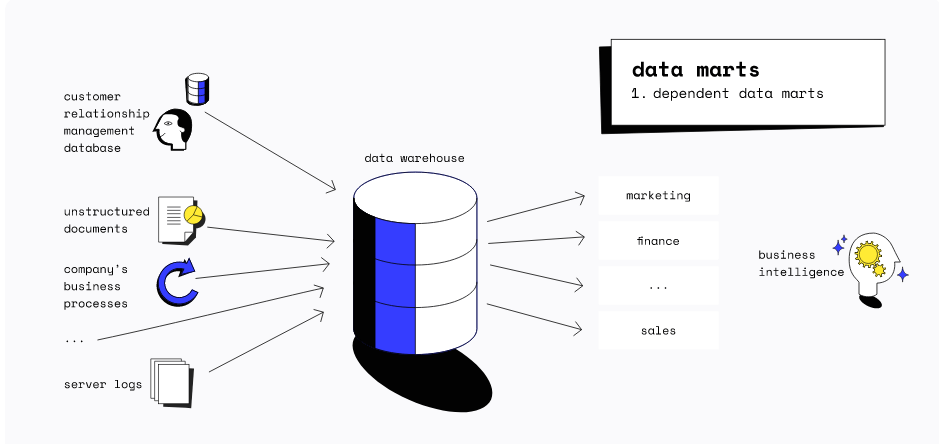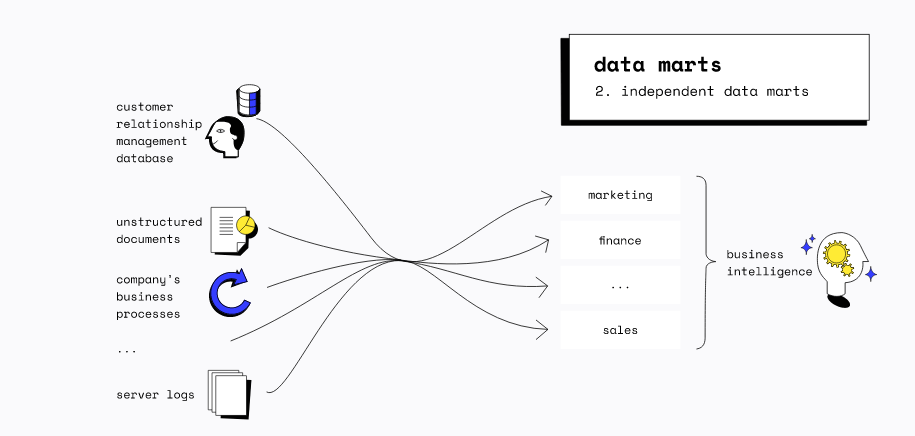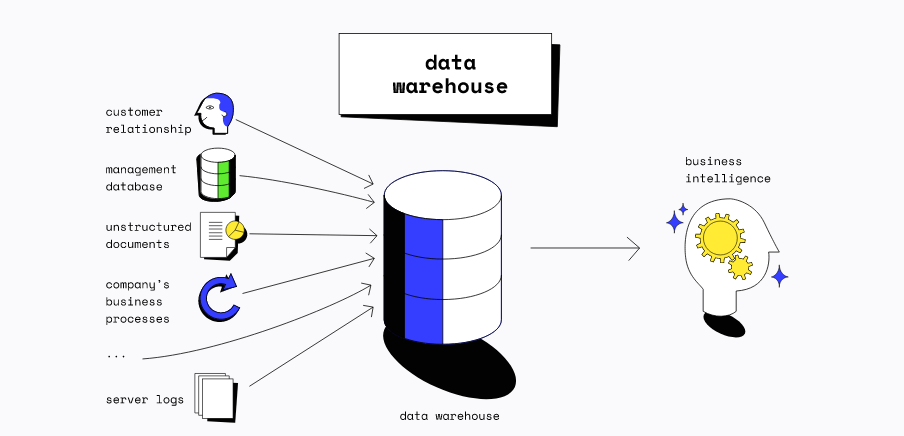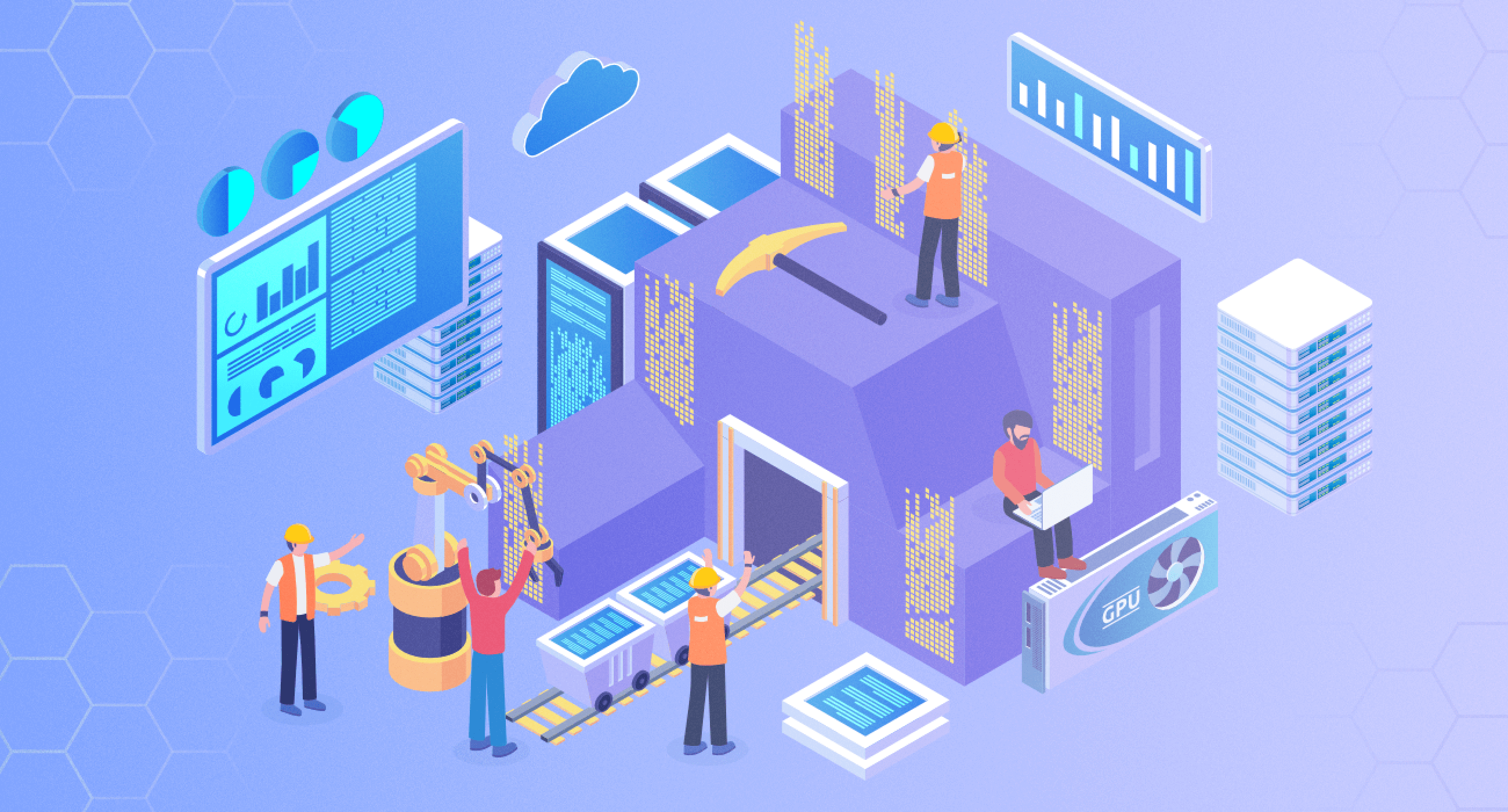As a marketplace for big data, we have all kinds of customers that have varying needs but are generally looking for one thing: business intelligence. This is where "data warehouse" and "data mart" come into play. But what exactly is the difference between data warehouse vs. data mart?
If we talk about the terms in business terminology, we may come to know that this subject is quite a hot topic. The differences between a data warehouse and a data mart can be subjective, but one isn't necessarily better than the other.
The decision on which type of database to use comes down to business requirements and industry best practices.

What is Data Mart?
A data mart is a subset of a data warehouse that serves a specific purpose and meets the needs of a particular department or business function. Data marts are often created to serve one department or division within an organization, such as marketing or sales.

The most common type of data mart is one that contains information from operational systems such as finance, human resources, and customer relationship management (CRM).
Data marts are typically implemented on top of an existing data warehouse platform to provide easier access to the data they contain. Suppose your organization already has an enterprise-wide database that stores business intelligence. In that case, you can use it as the foundation for your data mart by creating views into specific subsets of information stored in it. This allows users who need access only to certain parts of the more extensive database to use those views instead of having to query all of its contents.

What is Data Warehouse?
The data warehouse is a centralized repository of enterprise data that is integrated, cleaned, and transformed into a form suitable for business intelligence and analytical applications.

They often contain historical data from several sources and may be used to support multiple decision-making processes. The most common usage of data warehouses is to provide information to support business reporting needs.
Data warehousing is critical to any company's information technology (IT) infrastructure. They're designed to support an entire organization's business intelligence (BI) needs, not just one department. What differentiates a data warehouse from other data storage systems in that they're intended to serve as a central hub for all enterprise databases.
Data Warehouse vs. Data Mart
Data warehouse and data mart are two types of data repositories. A data warehouse is a massive collection of data that serves as an information source for many different departments. A data mart is a smaller, more specialized version of the data warehouse with a restricted set of data that serves one or more departments. Both data warehouse vs. data mart serves the same purpose. They collect, store, organize and analyze large volumes of internal data for use in business decision-making processes.
The key difference lies in the usage and application:
| Parameter | Data Warehouse | Data Mart |
| Usage | It is used to handle high volumes of data and large data sets. Everyone in an organization can access it, and it's often used for business intelligence purposes, such as reporting and analytics. | It is used for one specific department or subject area, such as marketing or sales. It can also be accessed by other departments who need access to part of the data that's stored in the mart but not all of it. |
| Objective | To provide an accurate picture of the business at any given point in time. It does this by providing users with access to all of their company's most important information in one place so that they can make informed decisions about their organization's future direction. | It focuses on providing access to only those pieces of information that are relevant to its particular department or team — for example, marketing or sales — rather than all facets of the organization as a whole. |
| Designing | It is designed to answer multiple questions across different departments and can be used as an ongoing solution. | It is designed to answer a specific question or solve a specific problem and can be used as a temporary solution. |
| Data Type | It contains multiple schemas (multi-schema model) that represent separate views at once. | It contains a single schema (single-schema model) that represents all views at once |
| Time to implement | It is a complex system that can take months or even years to design and implement. | It is typically much simpler, taking only weeks or months to develop. |
| Cost | It is built on an enterprise-wide scale, so it has higher overhead costs compared with a smaller, more specialized project. | They are much cheaper because they focus on specific areas within an organization. |
| Size | It is used to store a large volume of data and it is capable of processing large amounts of data at one time. It can also be used for historical analysis and trend analysis of data over some time. | It can only handle small volumes of data, and it may not be able to perform complex analyses on this stored information. |
| Scope | It is designed to store all business information over an extended period with an eye toward historical analysis. | It has a narrower focus; it may contain current or historical records related to a specific function or department within the company. |
| Source | It can only be built using SAP or Oracle databases because the design and implementation of these two applications are based on their respective relational database management systems (R犀利士 DBMS). |
It can be built using different types of data sources such as OLTP databases, operational data stores, and other specialized databases. In addition, they can also be created using both structured and unstructured data sources such as emails and documents. |
| Storage Location | It is stored in its dedicated database, which means that all of the information from different sources is consolidated into one place for easy access. | It is stored alongside other databases within the company's IT infrastructure — it doesn't have its database like a DW does — so there may be some overlap between marts if they're sharing space in the same database server(s). |
| Reporting requirements | It is used for reporting purposes and to provide an overview of your entire business operation. | It is used for reporting purposes at a more detailed level within each department or function within an enterprise. |
| Complexity | It may include tens or even hundreds of different databases that must be integrated into one coherent whole so they can be queried together as if they were one database. | It often consists of just one or two related databases — because they don't need this level of integration to achieve their goals. |
Data Warehouse Use Cases
Salesforce: Salesforce is a SaaS application that provides customer relationship management (CRM), sales force automation (SFA), and enterprise cloud computing services. Salesforce uses multiple data warehouses for its operations.
Organizations use data warehouses in three main ways:
Business Intelligence Analysis: Business intelligence tools are used by executives and managers to analyze large amounts of data and make strategic decisions based on those insights. They can also monitor KPIs or other performance metrics over time so that companies know whether they're doing well financially or need to adjust their strategy.
- Data Warehousing: Data warehousing involves storing large amounts of structured data so it can be accessed later for reporting purposes or for creating more sophisticated reports than would otherwise be possible with OLTP databases alone.
- Reporting and Analysis: Data warehouses are used for offline analysis and reporting. They store large amounts of historical data that can be used to generate reports and perform complex analyses. For example, a company may want to compare its sales figures from the last five years to see which regions have had the highest growth, or it may want to determine what products sell best during certain seasons or at certain times of the year. Data warehouses make it possible to answer these types of questions by using their large amounts of historical data.
- Predictive Analysis: Data warehousing allows organizations to use predictive analysis to analyze their current business processes as well as past trends and events to predict what will happen in the future. This helps them anticipate problems before they arise and take steps to prevent them from occurring in the first place. It can also help them plan for future needs by identifying trends that indicate how customers may behave or what new products or services could be offered.
- Content Management: Many organizations store content such as articles, blog posts and videos in their data warehouses instead of dedicated content management systems like SharePoint or Drupal because these systems don't scale well enough for large numbers of items (such as millions of blog posts).
Data Mart Use Cases
A data mart can serve as a source for real-time analytics, reporting, and dashboards. It allows for an organization to analyze its data in isolation from other enterprises. Data marts are commonly used when there is a need to analyze specific business units or departments within an enterprise. This could include sales, marketing, finance, and human resources among others.
They are useful for many business purposes, including operational reporting, analysis, and decision support. They're also useful for separating sensitive data from less-sensitive data (for example, credit card numbers).
The most common use cases for data marts include:
Business process optimization: Data marts are used to support business processes such as order entry, inventory management, or customer service. These processes often require specialized reports on the data that is needed to run them. These reports may not be relevant to other business units or departments within the organization.
Specific business functions: Data marts are also used to support specific business functions such as finance and sales and AI-powered marketing. These functions often require reports on their own unique data sets that are not relevant to other departments or functions within the organization.
Departmental needs: Each department may have its own needs for data analysis, reporting, and analysis tools. For example, the human resources department may want access to employee statistics so they can create new benefits programs for employees; however, this information does not need to be available across all departments in the company.
Conclusion
The key difference between a data warehouse and a data mart is the scale. A data warehouse stores an entire organization's information in one place, while a data mart is a subset of data from a data warehouse specific to a business function. Both are important to businesses, but as your business grows, upgrading your setup and putting some of your information into a data mart rather than relying on a full-scale data warehouse is wise.
The lesson learned here is that while both data warehouses and data marts serve a valuable purpose in the business world, choosing which is right for your specific needs is important.
Hopefully, you know more about data warehouse vs. data mart than you did when reading this post.















Leave a Reply